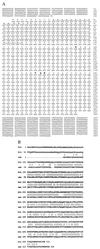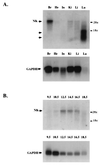Nlk is a murine protein kinase related to Erk/MAP kinases and localized in the nucleus
- PMID: 9448268
- PMCID: PMC18639
- DOI: 10.1073/pnas.95.3.963
Nlk is a murine protein kinase related to Erk/MAP kinases and localized in the nucleus
Abstract
Extracellular-signal regulated kinases/microtubule-associated protein kinases (Erk/MAPKs) and cyclin-directed kinases (Cdks) are key regulators of many aspects of cell growth and division, as well as apoptosis. We have cloned a kinase, Nlk, that is a murine homolog of the Drosophila nemo (nmo) gene. The Nlk amino acid sequence is 54. 5% similar and 41.7% identical to murine Erk-2, and 49.6% similar and 38.4% identical to human Cdc2. It possesses an extended amino-terminal domain that is very rich in glutamine, alanine, proline, and histidine. This region bears similarity to repetitive regions found in many transcription factors. Nlk is expressed as a 4. 0-kb transcript at high levels in adult mouse brain tissue, with low levels in other tissues examined, including lung, where two smaller transcripts of 1.0 and 1.5 kb are expressed as well. A 4.0-kb Nlk message is also present during embryogenesis, detectable at day E10. 5, reaching maximal steady state levels at day E12.5, and then decreasing. Nlk transiently expressed in COS7 cells is a 60-kDa kinase detectable by its ability to autophosphorylate. Mutation of the ATP-binding Lys-155 to methionine abolishes its ability to autophosphorylate, as does mutation of a putative activating threonine in kinase domain VIII, to valine, aspartic, or glutamic acid. Subcellular fractionation indicates that 60-70% of Nlk is localized to the nucleus, whereas 30-40% of Nlk is cytoplasmic. Immunofluorescence microscopy confirms that Nlk resides predominantly in the nucleus. Nlk and Nmo may be the first members of a family of kinases with homology to both Erk/MAPKs and Cdks.
Figures




References
-
- Songyang Z, Blechner S, Hoagland N, Hoekstra M F, Piwnica-Worms H, Cantley L C. Curr Biol. 1994;4:973–982. - PubMed
-
- Hanks S K, Quinn A M, Hunter T. Science. 1988;241:42–51. - PubMed
-
- Boulton T G, Nye S H, Robbins D J, Ip N Y, Radziejewska E, Morgenbesser S D, DePinho R A, Panayotatos N, Cobb M H, Yancopoulos G D. Cell. 1991;65:663–675. - PubMed
-
- Davis R J. Trends Biochem Sci. 1994;19:470–473. - PubMed
Publication types
MeSH terms
Substances
Associated data
- Actions
Grants and funding
LinkOut - more resources
Full Text Sources
Molecular Biology Databases
Miscellaneous

